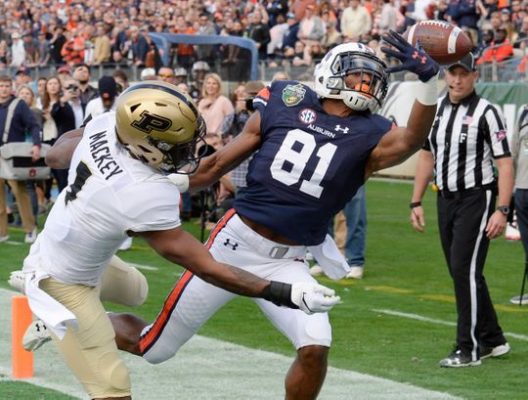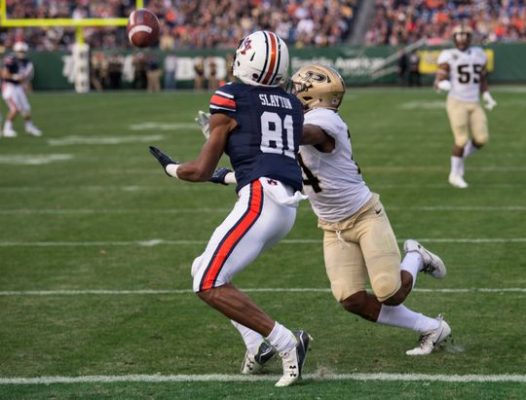News trend, Sport
Music City Bowl 5 takeaways from Purdue’s loss to Auburn
Music City Bowl 5 takeaways from Purdue’s loss to Auburn
Purdue didn’t have any answers, never found any and would still be searching for days to a come up with a solution.
Talk about being outplayed and severely exposed in a lot of areas. That’s what happened at Friday’s Franklin American Mortgage Music City Bowl. Purdue wasn’t close to being in the same class on the field with the Tigers.
It was 56-7. At halftime. It didn’t get better. The final score of 63-14 was the same margin but the second half was all about watching the final seconds mercifully click off the clock inside Nissan Stadium. The 63 points are the most scored by a Purdue opponent in program history.

“We did not play well and Auburn did and when you combined those things and we got frustrated as it went on and had some bad mistakes that cost us,” Purdue coach Jeff Brohm said. “It was a really bad first half we couldn’t overcome. Very disappointing.”
It’s hard to believe a Brohm-coached team would appear a million miles from an opponent. That was the case. Purdue couldn’t keep up if it placed 15 players on defense to slow the Tigers’ offense.
And offensively, the Boilermakers couldn’t generate a running game and couldn’t protect quarterback David Blough, who added his own mistakes to the program’s worst defeat in school history.

Here are the five takeaways:
► You feel bad for the seniors. Their last game shouldn’t be this lopsided but that’s sports, which often mirrors life. It’s hard to write your own script and have it finish in your favor. But this group of seniors will have a lasting impact on the program. They helped bring the Boilermakers from a sleepy decade of futility into relevance. It’s up to the underclassmen to build on what they did and make sure the program never experience this type of defeat again.
► What does Rondale Moore do for an encore in 2019? He’ll have more talent around him but his entrance into the college football world was nothing short of remarkable. He set the program’s all-purpose yardage record for a single-season and added 11 catches for 94 yards in the passing game. Moore is a special player but can’t carry the load himself. The upgrade in talent is coming and should benefit everyone involved.
► The Tigers just had too much skill. Across the board. At nearly every position. And it was clear coach Gus Malzahn had his team ready from the opening kickoff and knew where to attack the Boilermakers’ weakened defense. Auburn took deep shots and its receivers – particularly Darius Slayton – were running free behind cornerbacks Tim Cason, Antonio Blackmon and Dedrick Mackey. Kenneth Major was injured in practice last week, Brohm said and wasn’t spotted on the sidelines, but he wouldn’t have made a difference. Slayton caught three touchdowns in the first half totaling 160 yards. Improved cornerback play is a must going into the 2019 season.
► The wear and tear on the defensive line finally took its toll. Without Lorenzo Neal plugging up the middle, the Tigers ran right through the front when they wanted to. If they would’ve stayed with the run, they could have racked up a big game on the ground. Brohm was right – this game was won or lost in the trenches. Friday was another example of how fragile Purdue’s roster is, even though having Neal wouldn’t have made a difference in this outcome. Even losing a player like Brennan Thieneman, a backup with experience, doesn’t help. Thieneman sustained a broken fibula and tibia in the first quarter but he wasn’t alone. Right tackle Matt McCann suffered a knee injury that Brohm wasn’t optimistic about. The Boilermakers need their top players each week to compete with the best in the Big Ten, let alone in the Southeastern Conference.
► How could the Boilermakers dismantle Ohio State in October and receive this type of beating by Auburn in December? It’s called consistency, an area the program is trying to find. They looked great against ranked teams – the Buckeyes, Boston College and Iowa – but were lackluster against Eastern Michigan, Minnesota and Michigan State. It’s all part of the season. The youth on defense at the beginning was evident but it doesn’t fully explain the late-season play. The offense had its own consistent issues, looking great one week and below average the next. Reaching more of a middle ground is an important next step.

